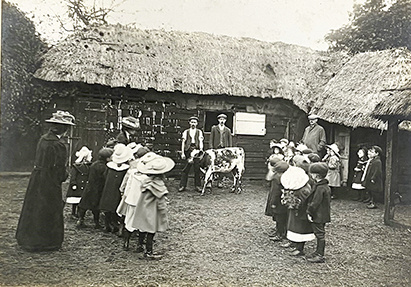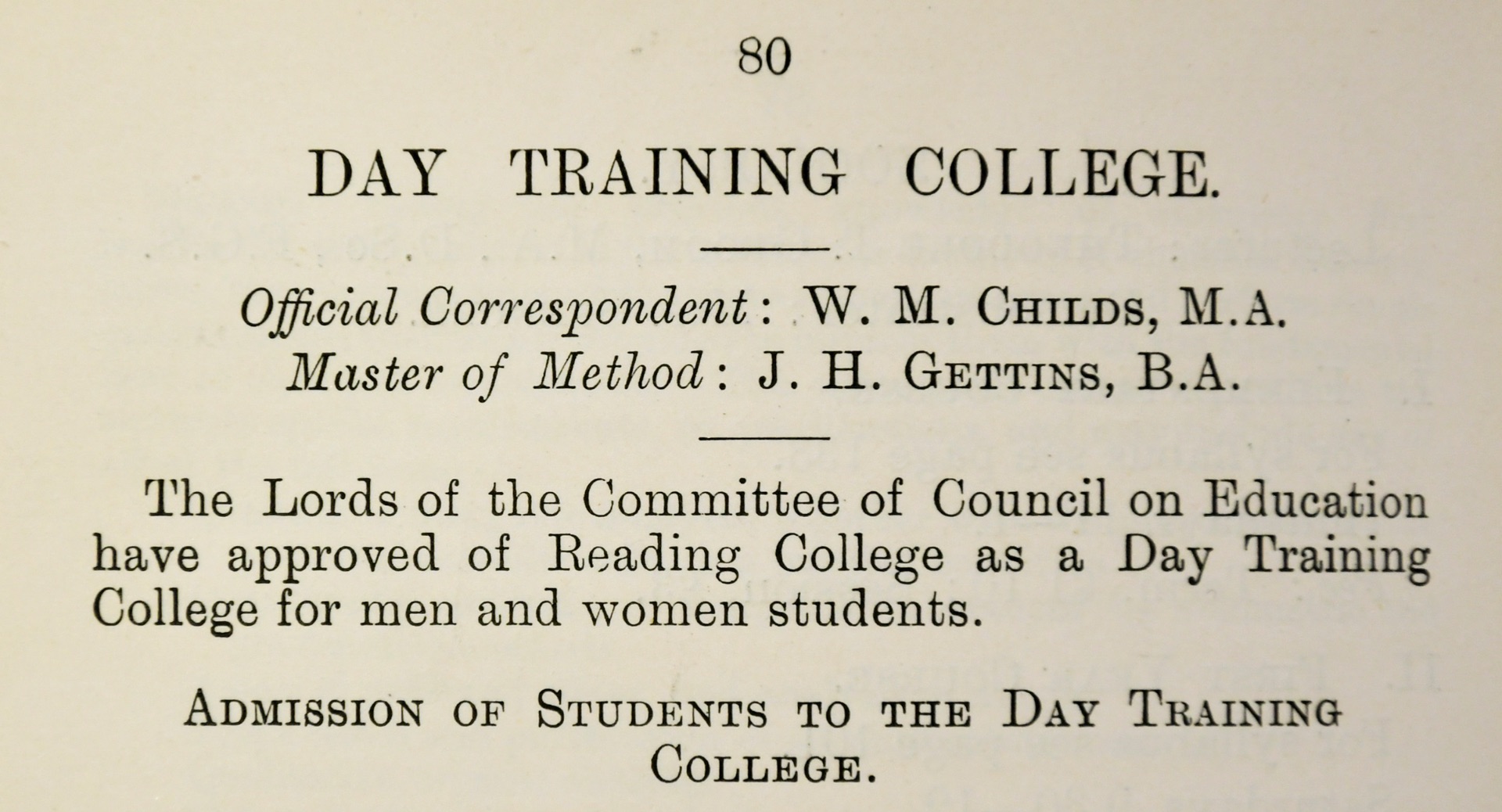Sometimes referred to as ‘the experimental outdoor school’, the Farm School at Shinfield was set up in June 1912 and continued until 1926. It was the brainchild of Herbert S. Cooke, Master of Method in the Education Department.
The motivation behind this initiative is explained in the College’s Annual Report for 1911-12: Cooke was trying to counteract a longstanding trend for student teachers to prefer employment in urban rather than rural schools and wanted to impress upon his students the opportunities afforded by education outside the school classroom. The Farm School took place during the weeks reserved for Teaching Practice in the summer term and at first involved second-year male trainees only. Female students were eventually included in the scheme following a suggestion from the Board of Education, although initially their involvement was just for one week, later extended to two.
The first group of pupils consisted of forty thirteen-year-old boys from Redlands Council School, the College’s ‘demonstration school’, who attended daily for two weeks. Lessons took place in the barn which was equipped with desks and teaching materials.
According to Cooke (1913) there had been a growing realisation during previous years that the curricula of urban and rural schools needed to be different, and a Rural Curriculum was devised that centred on nature study and rural science. Pupils engaged in agricultural arithmetic, measuring distance and volume, and studied cattle, crops and soils as well as fruit growing, pruning and grafting in the College’s experimental gardens. They learnt folk songs and dances, studied the architecture of the nearby church at Arborfield and sketched the landscape and barn under the guidance of Allen Seaby and Mr Pearce from the Department of Fine Arts.
Cooperation between the Education Department, the Faculty of Agriculture and Horticulture and the staff of Redlands Council School ensured the success of the venture. Reports in the College Review and Annual Reports give a special mention to Mr Cooke, to Mr Sweatman, the head teacher of the Boys Department at Redlands and Mr Pennington, a Lecturer in Agriculture who became the Farm Manager in 1914.
But perhaps the most telling testimony comes from the Annual Report referred to above:
‘The Board of Education Inspector of Training Colleges paid a special visit to the outdoor school and expressed the opinion that it was one of the best experiments he had ever seen in the training of young teachers for their future scholastic careers.’ (Annual Report, 1911-12, p. 41).
His Majesty’s Inspector of Training Colleges, Mr J. F. Leaf, suggested further that the two weeks be extended to three. This resulted in an extended curriculum where individual topics could be dealt with in greater depth and drew on the expertise of any trainee teachers who had specialist knowledge in relevant areas such as practical geography, plants, animals or gardening.
Two summers later, in 1913, the College Review reported the inclusion of girls as well as boys, and the participation of St John’s School in addition to the Demonstration School. The three weeks were further extended to four. The Farm School was now firmly established:
‘…what was once regarded as an experiment has now become an important factor in preparing the students for their professional career.’ (p. 186).
The scheme went from strength to strength and during its final three years sixty boys and sixty girls aged eleven to fourteen were invited. The children were from the poorer parts of the Borough and had all failed to qualify for secondary (grammar) schools.
The Timetable
Over the years, there was considerable variation in the makeup of the pupil groups and in the format of the school day. And for at least part of the time, the curriculum, number of weeks and transport arrangements differed between boy and girl pupils.
The most detailed account of the Farm School is to be found in an article by H. S. Cooke published in the College Review in 1913. From this and other sources such as Isabella Campbell’s and Albert Wolters’s retrospective accounts written in 1949, we can reconstruct an approximate format of a day for the boys. I can’t claim this to be a ‘typical day’, but it is certainly a possible one:
-
- The children walked or cycled from Silver Street in town. Some arrived as early as 8.30 and took part in what Isabella Campbell referred to as ‘much intensive cricket practice’ (p. 34).
- 9.30: School opened.
- 9.45: Assembly at the barn, prayers and exercises.
- 9.50: Each pupil recorded weather observations.
- 10.00: Pupils divided into groups for Farm Arithmetic.
- 10.55: Break.
- 11.10: Outdoor geography, nature work, e.g. walk to the River Loddon to measure variations in the speed of flow and the reasons for them (on one occasion a child had to be fished out of the river!).
- 1.00: Midday break – the College Farm provided milk; lunch was eaten under the trees; the students organised games of cricket and football while College staff congregated in the ‘Black Boy’ (now the ‘Shinfield Arms’) where they conducted what Albert Wolters referred to as ‘vigorous and animated discussions’!
- 2.15: The trainee whose turn it was to be Headteacher blew the whistle and pupils and students moved to the farm for lessons on topics such as soil, cattle, fruit trees, pests, ploughing, farm implements, etc.
- 4.15: Tidying up, prayers and a hymn.
The curriculum for girls appears to have concentrated more on areas such as dairy produce and poultry keeping, together with training in first aid. There was daily folk dancing.
Sadly, the Farm School was discontinued after the transition from University College Reading to the University of Reading in 1926. The priority for the Education Department moved from primary schools to postgraduate secondary training, and for practical reasons teaching experience could no longer be delayed until the summer term.
Writing in 1949 to celebrate fifty years of Teacher Education at Reading, Professor Albert Wolters, by then Head of the Psychology Department, described the Farm School as ‘our greatest experiment‘. Quite an accolade from one of the most distinguished scholars in the University’s history!

On Reflection
I am struck by the coincidence that, as well as being the beginning of the Farm School, 1912 marked the publication of Eliza Chattaway’s ‘School Nature Rambles’. At the time, Chattaway was head of the Infants Department at Redlands Council School and had already been taking pupils on educational visits to the Shinfield Farm, details of which are documented in her book.
In the preface she gives thanks to H. S. Cooke for checking the proofs and I can’t help wondering to what extent Cooke was inspired by this pioneer of outdoor learning in developing the concept of the Farm School.
The compilation of a first academic biography of Eliza Chattaway is currently being supported by the Undergraduate Research Opportunities Programme (UROP) under the leadership of Dr Rhianedd Smith (University Museums and Special Collections Services). The research is being conducted by Leah Rashid. On completion, the biography will appear on the website of the Berkshire Record Office.
I can’t guarantee that the images below of Eliza Chattaway with her pupils from Redlands School were taken on the College farm, but it seems likely.


Note
There is a discrepancy about the continuation of the Farm School during World War I – the Redlands School logbooks show it to have been suspended between 1915 and 1918, whereas H. Armstrong of the College states that it took place every year except 1918. This inconsistency might be explained by the fact that Redlands was evacuated in 1915 when its buildings became a temporary military hospital. Presumably the Farm School continued with pupils from elsewhere during this period; the College’s annual report for 1916-17, for example, states that:
‘The outdoor school was held in June on the College Farm. A new feature of this year’s work was the preparation and cooking of the midday meal by the students and school-pupils.’ (p. 20).
Thanks
To Dr Rhianedd Smith (University Museums and Special Collections Services) and Mark Stevens (County Archivist, Berkshire Record Office) for their help.
Sources
Armstrong, H. (1949). A brief outline of the growth of the Department. In H. C. Barnard (Ed.), The Education Department through fifty years (pp. 9-17). University of Reading.
Campbell, I. E. (1949). The farm school, 1912-1926, and the development of courses in rural science for intending teachers. In H. C. Barnard (Ed.), The Education Department through fifty years (pp. 33-6). University of Reading.
Chattaway, E. (1912). School nature rambles. London: Hodder & Stoughton.
Childs, W. M. (1933). Making a university: an account of the university movement at Reading. London: J. M. Dent & Sons Ltd.
Cooke, H. S. (1913). An outdoor school. The Reading University College Review, Vol. VI, No. 16, pp. 56-66.
Curtis, S. J. (1949). Early days. In H. C. Barnard (Ed.), The Education Department through fifty years (pp. 23-5). University of Reading.
The Reading University College Review, Vol. IV, August 1912.
The Reading University College Review, Vol. VI, No. 18, Aug 1914.
Rooke, P. (1991). Redlands: a hundred years at school, 1891-1991. Reading: Redlands School Parents’ Teacher Association.
University College Reading, Annual Report and Accounts, 1911-12, 1912-13 & 1916-17.
Wolters, A. W. (1949). Early days. In H. C. Barnard (Ed.), The Education Department through fifty years (pp. 18-20). Reading: University of Reading.


